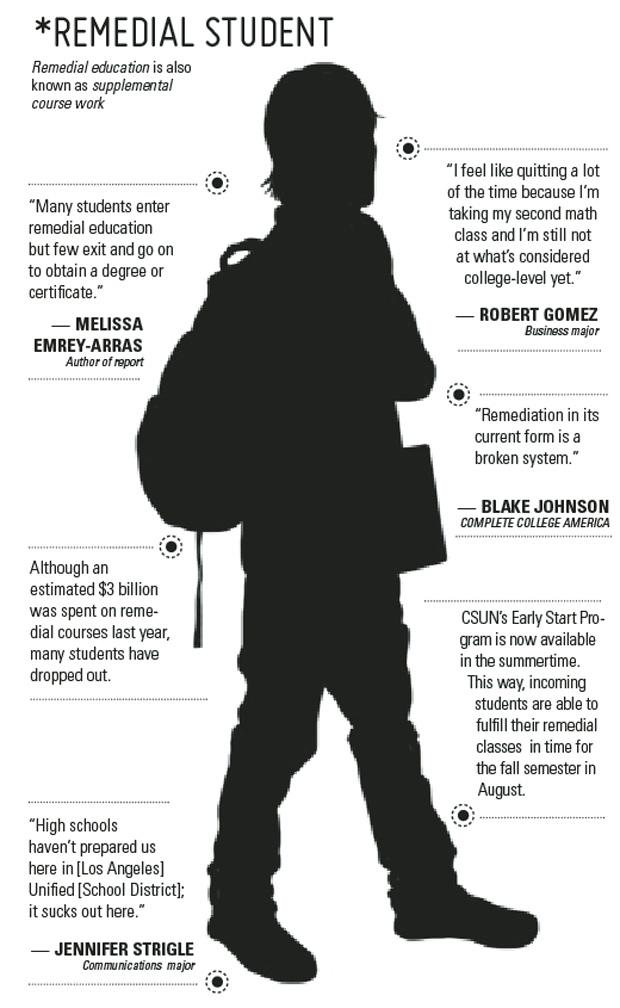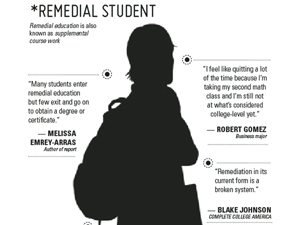
Robert Gomez, 19, sophomore business major at CSUN, feels discouraged by the remedial, also known as supplemental instruction, work required for him.
“I feel like quitting a lot of the time because I’m taking my second math class and I’m still not at what’s considered college-level yet,” said Gomez.
Gomez said if he passes his remedial math course this semester, he will then move on to college-level math. He said taking these courses either in the summertime or at a community college could have prevented his negative feelings about graduating.
However, due to the discouragement remedial education gives students like Gomez, some feel that the system is broken and that graduation rates will continue on a downward spiral.
A recent report from the United States Government Accountability Office (GAO) found that incoming college students taking remedial courses also have less of a chance finishing their degree.
The author of the report, Melissa Emrey-Arras, said the current state of remedial education is a cause for much concern.
“Many students enter remedial education but few exit and go on to obtain a degree or certificate,” said Emrey-Arras. “That being said, what works or the changes that should be made to remedial education is lacking.”
Remedial education consists of courses in math and English that need to be repeated after high school to ensure a student is well prepared for college-level coursework. These classes are viewed as prerequisites and are meant to provide a helpful resource for students so that they don’t feel overwhelmed by college and the higher level of work it demands.
However, colleges do not provide credit for remedial courses. In order to graduate, students must earn a certain amount of credits, so for those taking these prerequisite courses such as Gomez, it may seem like a setback.
Jennifer Strigle, communications major, said the main problem is what students are not learning before entering college.
“High schools haven’t prepared us here in [Los Angeles] Unified [School District]; it sucks out here,” said Strigle. “It starts from the teachers but the teachers also need help in their preparation.”
Emrey-Arras said many community colleges are working with their local high schools to ensure they are being well prepared for college. These efforts include curriculum changes at the high school level to better align with the community college curriculum or earlier assessments of students in high school so they have time to take the right courses prior to their entrance exams for community college.
“The hope is that these efforts will result in fewer high school students needing to take developmental education courses after graduating high school and entering community college, ” said Emrey-Arras.
The only problem with this system is many high school students don’t attend community college right away, according to Emrey-Arras. There is usually a gap in between, which causes students to forget the remedial coursework they have been taught. In doing so, they are setting themselves back, which is why they fall behind on their math and English skills.
“Many have been away from school and need a refresher in basic math and English,” said Emrey-Arras.
CSUN students take an entrance exam admission, called the Early Start Program, which determines what kind of remedial courses are necessary before they reach college level. Incoming freshman must take both the English Placement Test (EPT) as well as the Entry Level Mathematics test (ELM).
If a student scores less than 138 in the English portion of their entrance exam, they must enroll in a remedial course to catch up. The same goes for math. A score less than 50 on the exam constitutes for a remedial course in that subject.
Adry Gomes, junior child development major, said he never had to take remedial classes.
“At the high school level, what really helped me was taking AP courses, but I know that a lot of people don’t have that option because they have to obviously be doing well to be offered a spot in AP classes,” said Gomes. “So I assume that in regular classes, they need to start doing some of the things that they do in AP classes – giving more homework, more reading, challenging them [the students] more. I know that helped me a lot because I did take a lot of regular classes and we didn’t do that much and the AP classes are what really prepared me.”
CSUN’s Early Start Program is now available in the summertime. This way, incoming students can get their remedial classes out of the way, in time for the fall semester in August.
Katherine Stevenson, director of developmental mathematics, is optimistic about the results achieved by students who participated in the program last summer.
“This year we moved 300 students out of developmental math altogether and reduced the developmental math requirements from two courses to one for 600 students,” said Stevenson.
Stevenson said 33,000 students participated in the program in the summer of 2013, 400 of which were in physical classroom settings and the other 2,000 online.
Another study done by Complete College America (CCA) discusses implementing new policies that could possibly improve the situation for students.
CCA views the remediation system as a “bridge to nowhere” and despite the high hopes remediation programs provided at first, recent years have shown the system which intended on preparing students for college-level work has only pushed them further away.
Although an estimated $3 billion was spent on remedial courses last year, many students have dropped out. Less than one in 10 students graduate from community colleges within three years and little more than a third complete bachelors degrees in six years according to the CCA.
The CCA study uses a concept called “The Big Idea,” where instead of spending countless dollars on remedial courses, students should be exposed to a program called “Just-In-Time Tutoring.”
Just-In-Time Tutoring suggests, for example, that instead of only going to math class three times a week, students would attend five days out of the week. The extra two days would be spent on tutoring the students and bringing them up to speed on certain things on which they might be falling behind. This way, students will get the preparation they need while still receiving credit for graduation.
CCA believes that concept can help decrease the amount of students dropping out early and increase the number of students graduating with a degree or certificate.
“Remediation in its current form is a broken system,” said Blake Johnson from the CCA. “We need to ensure that many more students begin college-level courses with Just-In-Time support.”
CSUN education professor Ivan Cheng has joined the Just-In-Time bandwagon, and agreed students should be brought up to speed using the method introduced by the CCA.
“My own thinking is that support might be more effective if it is provided in a ‘Just-In-Time’ manner,” said Cheng. “In other words, instead of giving students a semester of math, maybe identify what they are not proficient with and provide tutorials as those skills are needed.”
Cheng said if a student does not have the necessary skills to complete coursework, then something must be done to support that student. He also said ‘remedial’ is a loaded word and suggests a flaw in the individual.
“Too often, students are labeled as remedial as if they are incapable of mastering college level work. I think we are all remedial at some point on some things.”
Cheng admits that he could use some remediation himself and it isn’t anything to be ashamed of.
“I am not as sharp as I used to be in writing computer programs because I haven’t done it since my freshman year in college,” said Cheng. “And with all the changes in technology and programming, I would need remediation if I needed to write a program.”





